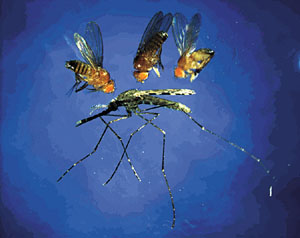 | Pictured here is a female mosquito and some of the mutant fruit flies that scientists used in their quest to identify the smell receptor that attracts mosquitoes to humans. The researchers cloned mosquito "smell genes" to the fruit flies and tested them for their sensitivity to human sweat. |
Yale scientists have identified a mosquito smell receptor that specifically detects a chemical component of human sweat, a finding that may provide the basis for developing insect repellants for humans or for agricultural crops.
Their discovery was reported in the Jan. 15 issue of the journal Nature.
Every year more than a million people worldwide die of malaria, a disease carried by the Anopheles mosquito. The bite of a female mosquito, feeding on human blood, transmits the malaria parasite.
Insects transmit many devastating human diseases and cause agricultural crop destruction. Finding how particular insects are attracted to humans or plant species is a key to easing these problems.
John Carlson, professor of molecular, cellular and developmental biology, and Yale graduate student Elissa Hallem created a way to identify specific mosquito smell receptors and the chemical components of human sweat that activate them.
"We expressed mosquito odor receptors in an engineered fruit fly neuron that we use as a 'decoder,' and then looked for compounds that activate or inhibit them," Carlson says. "It is a system that could be used to identify chemicals that might act as insect repellents or as attractants in insect traps."
Antennae of insects are the organs that carry odor receptors. The researchers used mutant fruit flies that lack the smell receptor in a nerve cell on their antennae. They cloned mosquito smell receptor genes and expressed them in the mutant fruit fly nerve cell.
The fruit flies with mosquito "smell genes" were tested for their sensitivity to different chemical components of human sweat. Electrophysiological measurements showed when the flies were stimulated. One particular compound, 4-methyl phenol, which is found in human sweat, potently activated a mosquito receptor that is only expressed in female mosquitoes and that stops being made after a mosquito has had a meal of blood.
Other authors on the paper are Laurence J. Zwiebel and A. Nicole Fox of Vanderbilt University. This work was funded by grants from the National Institutes of Health and a National Science Foundation Fellowship to Elissa Hallem.
-- By Janet Rettig Emanuel
T H I S
Scientists discover how mosquitoes
smell their human prey
 W E E K ' S
W E E K ' S S T O R I E S
S T O R I E S![]()
 Hair dye use may boost risk of cancer
Hair dye use may boost risk of cancer![]()
![]()
 Yale physician who helped Iranian earthquake relief efforts . . .
Yale physician who helped Iranian earthquake relief efforts . . .
![]()
![]()
 New Kahn chair to bring young architects to Yale
New Kahn chair to bring young architects to Yale
![]()
![]()
 'Hatching the Past' explores dino-bird link
'Hatching the Past' explores dino-bird link
![]()
![]()
 Exhibit underscores Yale research showing birds as 'living dinosaurs'
Exhibit underscores Yale research showing birds as 'living dinosaurs'
![]()
![]()
 Japanese chess champion balances strategizing and study
Japanese chess champion balances strategizing and study
![]()
![]()
 Exhibit explores experiences of black soldiers in the Civil War
Exhibit explores experiences of black soldiers in the Civil War
![]()
![]()
 Campus celebration of Black History Month features an array of events
Campus celebration of Black History Month features an array of events
![]()
![]()
 Scientists discover how mosquitoes smell their human prey
Scientists discover how mosquitoes smell their human prey
![]()
![]()
 Studies shed light on struggle to quit smoking
Studies shed light on struggle to quit smoking![]()
 Bipolar disorder linked to decrease in brain structure governing emotions
Bipolar disorder linked to decrease in brain structure governing emotions
![]()
![]()
 Study: Post-traumatic stress disorder . . .
Study: Post-traumatic stress disorder . . .
![]()
![]()
 Heavy rainfall not only wears down mountains . . .
Heavy rainfall not only wears down mountains . . .
![]()
![]()
 Drama School to stage contemporary Irish comedy
Drama School to stage contemporary Irish comedy
![]()
![]()
 Leading art critics featured in new discussion series
Leading art critics featured in new discussion series
![]()
![]()
 Search committee named for Yale College Dean
Search committee named for Yale College Dean
![]()
![]()
 New SOM advisory board will discuss the school's mission and goals
New SOM advisory board will discuss the school's mission and goals
![]()
![]()
 Yale neurologist honored for contributions to epilepsy research
Yale neurologist honored for contributions to epilepsy research
![]()
![]()
 Campus Notes
Campus Notes
![]()
Bulletin Home |
| Visiting on Campus
Visiting on Campus |
| Calendar of Events
Calendar of Events |
| In the News
In the News![]()
Bulletin Board |
| Classified Ads
Classified Ads |
| Search Archives
Search Archives |
| Deadlines
Deadlines![]()
Bulletin Staff |
| Public Affairs
Public Affairs |
| News Releases
News Releases |
| E-Mail Us
E-Mail Us |
| Yale Home
Yale Home